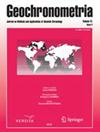中国南方虎须山旧石器时代遗址的年代:由多种发光测年技术推断
IF 0.9
4区 地球科学
Q3 Earth and Planetary Sciences
引用次数: 2
摘要
湖南北部虎徐山考古遗址是最近发掘的一处遗址,出土了手斧等石器。该遗址的沉积物是化学风化的,这使得除了光学激发发光(OSL)方法外,很难使用数值测年技术来确定该遗址的年代。在这里,我们使用了各种发光程序,包括细粒石英的单组分再生剂量(SAR),灵敏度校正的多重组分再生剂量(SMAR)和热传递光学激发发光(TT-OSL) SAR程序,以及细粒多矿物组分的两步红外后红外激发发光(pIRIR)和多高温pIRIR (MET-pIRIR)程序。结果表明:石英细粒具有优异的发光性能,除1个样品外,其余样品的SAR-、SMAR-和TT-OSL年龄基本一致,且按地层顺序排列。细粒多矿物组分的pIRIR和MET-pIRIR信号相对较弱,导致MET-pIRIR信号的剂量响应曲线难以构建,且pIRIR(100,275)年龄在地层上不一致。7个样品的石英OSL年龄在62 ~ 133 ka之间。这两个来自文化层的样品用不同的方法在细石英上测定了78至92 ka。然而,考虑到两个样品的精细多矿物颗粒获得的系统更老的pIRIR年龄,它们的石英OSL年龄被认为代表了该层的最小年龄,它们的pIRIR(100、275)年龄118和110 ka代表了年龄上限,表明该地点在海洋同位素第5阶段被人族占据。本文章由计算机程序翻译,如有差异,请以英文原文为准。
Chronology of the Huxushan Paleolithic site in south China: Inferred from multiple luminescence dating techniques
Abstract The Huxushan archaeological site in northern Hunan Province, China, was recently excavated, from which stone tools including handaxes were unearthed. The deposits of the site are chemically weathered, which makes it difficult to date the site using numerical dating techniques except for optically stimulated luminescence (OSL) method. Here, we used various luminescence procedures including single-aliquot regenerative-dose (SAR), sensitivity-corrected multiple-aliquot regenerative-dose (SMAR) and thermally transferred optically stimulated luminescence (TT-OSL) SAR procedures on fine-grained quartz, and two-step post-infrared infrared stimulated luminescence (pIRIR) and multi-elevated-temperature pIRIR (MET-pIRIR) procedures on fine polymineral fractions. The results show that the fine quartz grains have excellent luminescence properties and the quartz SAR-, SMAR- and TT-OSL ages for the samples agree with each other and in stratigraphical order except for one sample. The fine polymineral fractions exhibited relatively weak pIRIR and MET-pIRIR signals, resulting in difficulty in constructing the dose-response curve for MET-pIRIR signals and the stratigraphically inconsistent pIRIR(100, 275) ages. The seven samples yielded their quartz OSL ages ranging from about 62 ka to 133 ka. The two samples from the cultural layer was dated to 78 to 92 ka using different procedures on fine quartz . However, given the systematically older pIRIR ages obtained with the fine polymineral grains for the two samples, their quartz OSL ages are considered to represent the minimal ages of this layer, and their pIRIR(100, 275) ages of 118 and 110 ka represent the upper age limit, indicating that the site was occupied by hominins during Marine Isotope Stage 5.
求助全文
通过发布文献求助,成功后即可免费获取论文全文。
去求助
来源期刊

Geochronometria
地学-地球科学综合
CiteScore
2.20
自引率
0.00%
发文量
1
审稿时长
>12 weeks
期刊介绍:
Geochronometria is aimed at integrating scientists developing different methods of absolute chronology and using them in different fields of earth and other natural sciences and archaeology. The methods in use are e.g. radiocarbon, stable isotopes, isotopes of natural decay series, optically stimulated luminescence, thermoluminescence, EPR/ESR, dendrochronology, varve chronology. The journal publishes papers that are devoted to developing the dating methods as well as studies concentrating on their applications in geology, palaeoclimatology, palaeobiology, palaeohydrology, geocgraphy and archaeology etc.
 求助内容:
求助内容: 应助结果提醒方式:
应助结果提醒方式:


